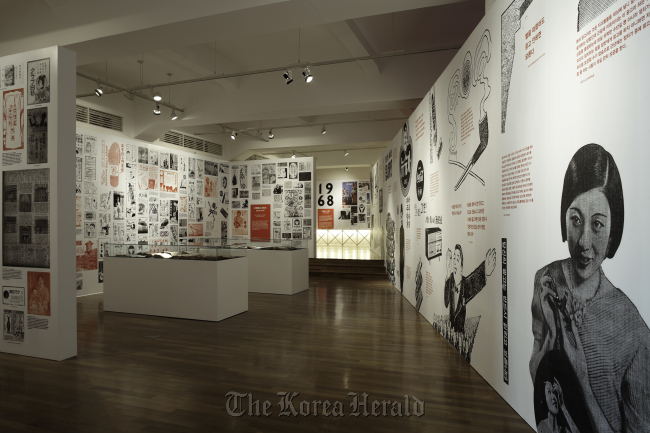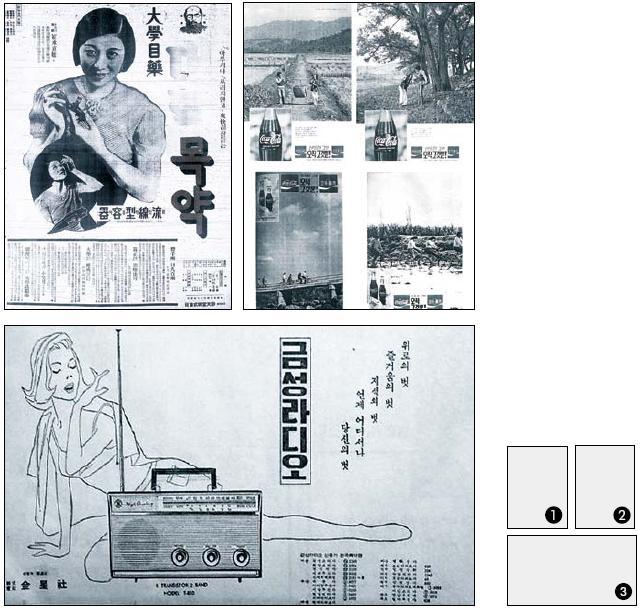Exhibition takes visitors through 120 years of advertising in Korea
Advertising has responded to social changes, trends and lifestyles of people over the years.
But behind the simple overview lies the fact that advertising in Korea is also a byproduct of the turbulent days of its modern history, influenced by Japanese colonial rule and, more recently, globalization.
The chronological tour of the 120 years of advertising in Korea at Ilmin Museum of Art offers an in-depth view of everyday life impacted by external influences. The most comprehensive exhibition on Korea’s advertising history thus far also depicts the general evolution of advertising.
Advertising has responded to social changes, trends and lifestyles of people over the years.
But behind the simple overview lies the fact that advertising in Korea is also a byproduct of the turbulent days of its modern history, influenced by Japanese colonial rule and, more recently, globalization.
The chronological tour of the 120 years of advertising in Korea at Ilmin Museum of Art offers an in-depth view of everyday life impacted by external influences. The most comprehensive exhibition on Korea’s advertising history thus far also depicts the general evolution of advertising.

“Confession: Advertisement, Art and the Public” evokes nostalgia for the old days in older visitors and for the younger ones, offers a vivid showcase of what life was like back in the early days of modern Korea.
The exhibition features advertisements dating back to when Western culture and trade were first introduced in Korea in 1876 to the present day, and examines the cultural and social values they portray.
“It can also be viewed as a confession of modern consumerism and an attempt to interpret the values of modern society and the public using advertisement as a medium,” said Kim Tae-ryung, director of Ilmin Museum of Art.
Ironically, “confession” was the word used to refer to advertisement during the 19th century. The first newspaper advertisement of a trade company was called “Deoksang Saechang Yanghaeng Confession,” which means the confession of the trade company Saechang to people.
The ad lists the products the company imports to and exports from Korea on a blank page without any rhetorical expressions or explanations ― simply “confessing” to consumers what they sell.
But after a decade, the word “gwango,” meaning advertisement, replaced “confession” as advertising was no longer about telling people honest facts about products. Advertising’s primary aim now was to promote products to boost sales.
Early forms of advertisements in Korea were influenced by Japanese culture during the Japanese colonial rule from 1910 to 1920 and began to appear on newspapers, fliers and sign boards.
The Japanese Sapporo beer was labeled as the “national brand,” reflecting the reality under Japanese rule as the advertising market was filled with Japanese products.
The Japanese colonial rule affected advertisements in other ways as well. For example, an ad chronicled a gentleman’s day from morning to evening featuring multiple Japanese-brand products that he would use at different hours of the day. By showing the exact times at which certain activities were performed and implying punctuality as a requirement of a gentleman, the ad sought to “reform” the Korean who the Japanese colonizers portrayed as being largely ignorant of time and prone to perpetual tardiness.
Ads linking celebrities to products’ image began to appear around this time, too.
Choi Seung-hee, a pioneer of modern dance, was the first model to appear in a newspaper advertisement for eye drops in 1937.
The advertisement industry went into decline as Japan started the Pacific War in 1940 and eventually surrendered in 1945.
Following Korea’s liberation, Korean language began to replace Japanese words and about 70 percent of newspaper advertisements were filled with movie posters, reflecting the trend in which people sought pleasure and happiness after a half-century of hardships under colonial rule and war.

The advertisement for a radio, first manufactured by Gold Star, the former brand name of LG Electronics, marked the start of contemporary advertisement in 1959, which soon broadened the advertisement medium from text to sound.
The Coca-Cola advertisement, first emerging here in 1969, presented new ways to express products with English slogan and catchy songs.
Based on the advertising techniques accumulated over the last 100 years, today’s advertisements have become larger and more dramatic, filled with promises that entice people into mass consumerism.
On the second floor of the museum, contemporary artists present artworks that best represent some of the key images of consumerism such as success, sexuality, trust and identity.
The artist Nanda shows a world governed by materials and consumerism with her works “Coca Christmas,” “Dunkin Halloween Day,” and “Hershey’s Valentine.”
Other artists directly criticize excessive consumption while others quietly point out hidden meanings in advertisements and key words that influence today’s society.
“Confession: Advertisement, Art and the Public” continues through Aug. 19 at Ilmin Museum of Art in Gwanghwamun, Seoul.
For more information, visit www.ilmin.org.
By Lee Woo-young (wylee@heraldcorp.com)
-
Articles by Korea Herald






![[From the Scene] Monks, Buddhists hail return of remains of Buddhas](http://res.heraldm.com/phpwas/restmb_idxmake.php?idx=644&simg=/content/image/2024/04/19/20240419050617_0.jpg&u=20240419175937)








![[From the Scene] Monks, Buddhists hail return of remains of Buddhas](http://res.heraldm.com/phpwas/restmb_idxmake.php?idx=652&simg=/content/image/2024/04/19/20240419050617_0.jpg&u=20240419175937)

![[KH Explains] Hyundai's full hybrid edge to pay off amid slow transition to pure EVs](http://res.heraldm.com/phpwas/restmb_idxmake.php?idx=652&simg=/content/image/2024/04/18/20240418050645_0.jpg&u=20240419100350)

![[Today’s K-pop] Illit drops debut single remix](http://res.heraldm.com/phpwas/restmb_idxmake.php?idx=642&simg=/content/image/2024/04/19/20240419050612_0.jpg&u=)